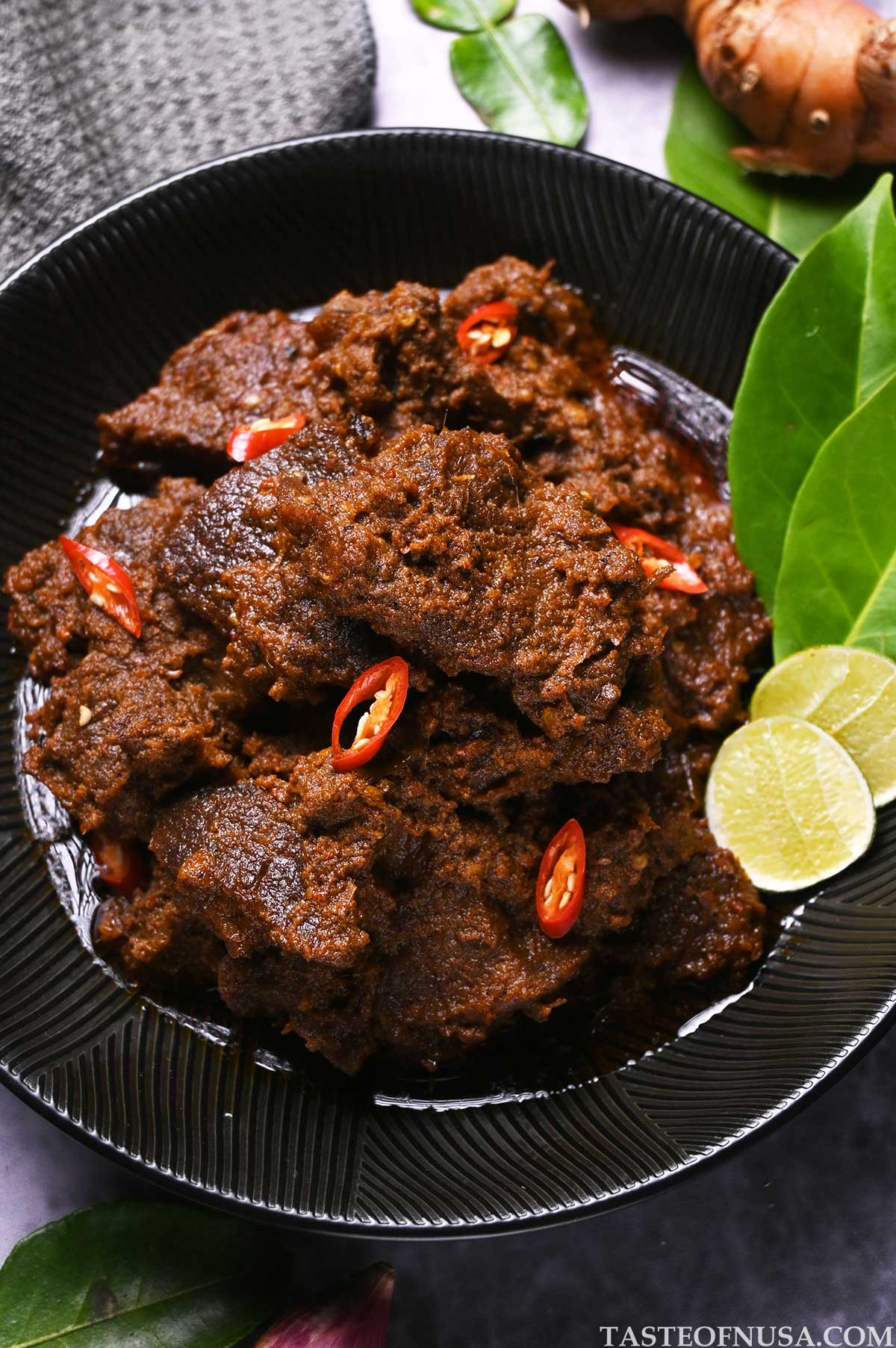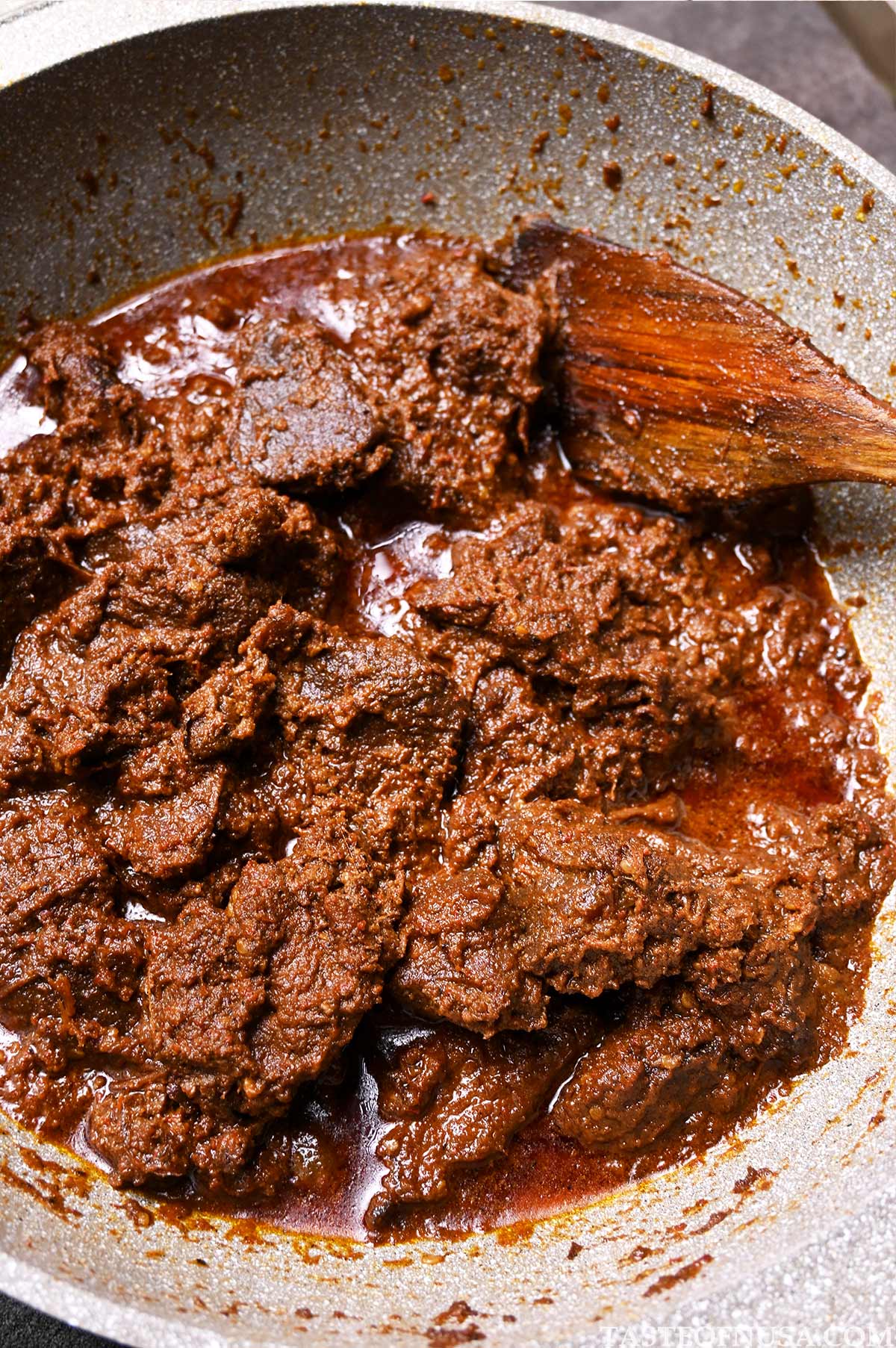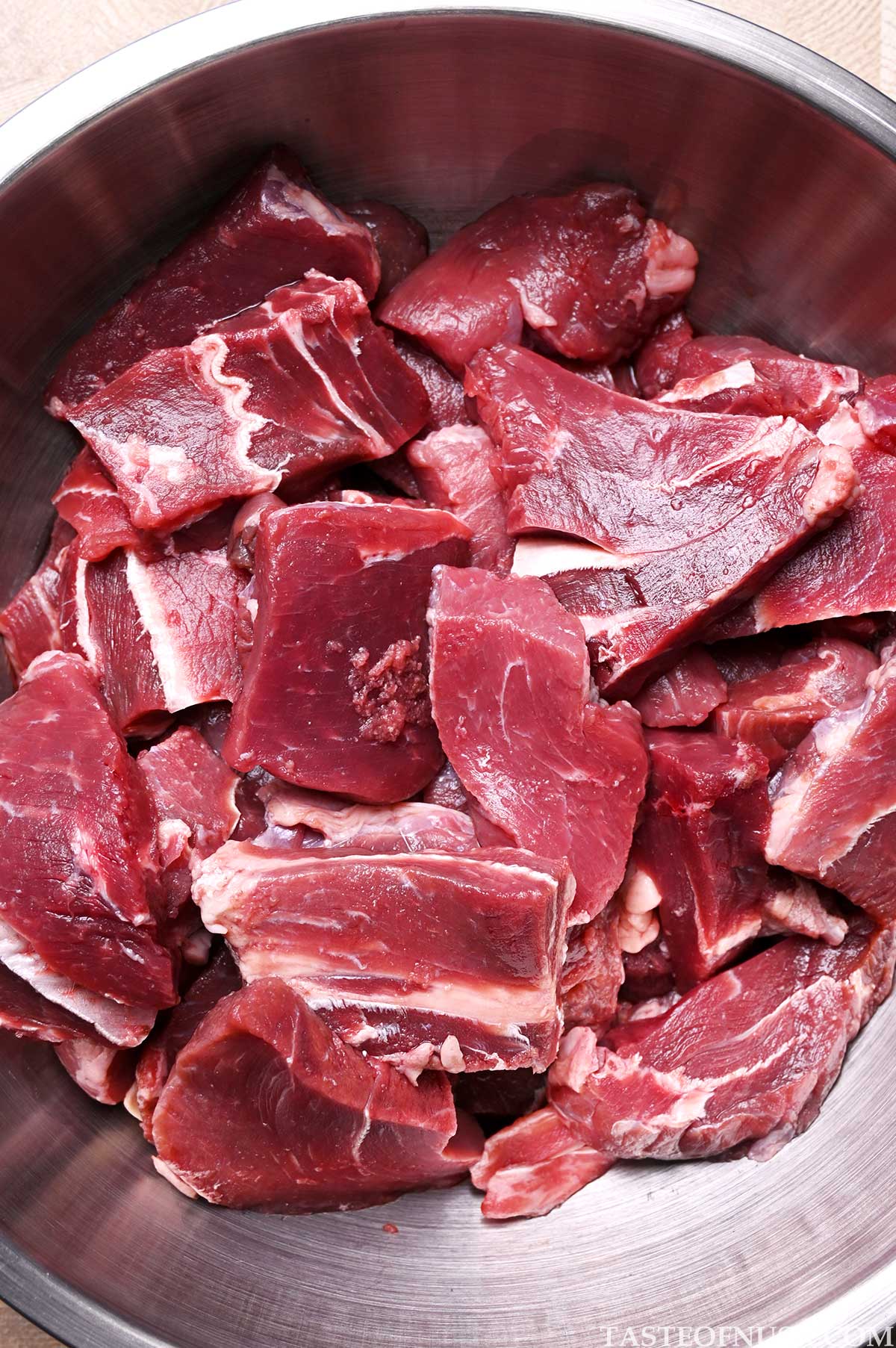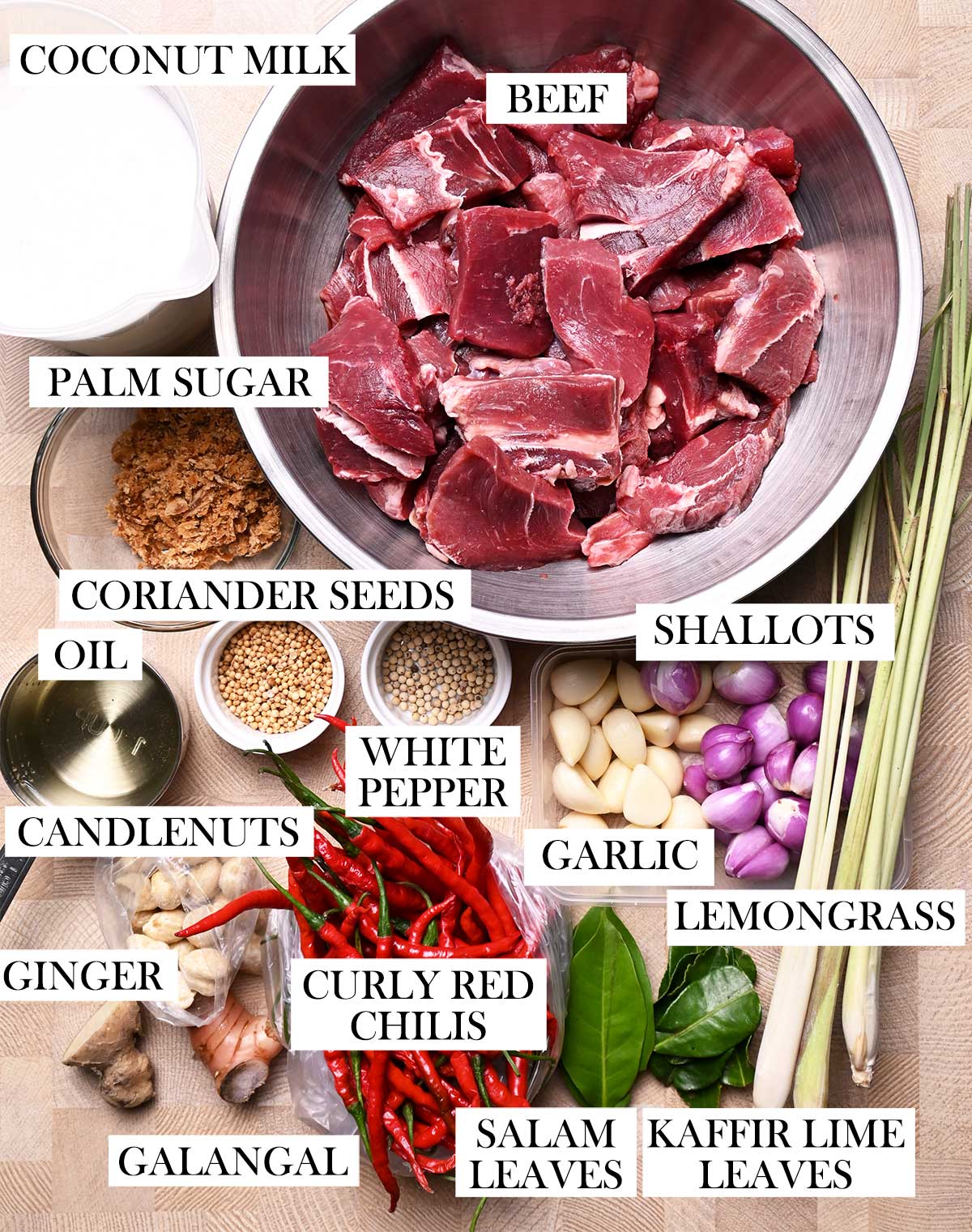Beef Rendang (Javanese-Style)
This Beef Rendang recipe is an absolute keeper! It is a popular Indonesian dish with flavourful chunks of beef that are slowly braised in an aromatic spiced coconut gravy that will keep you coming back for more.

With its enormous geographic and cultural diversity across the archipelagos, it is evident that Indonesian cuisine is rich in variety and taste. Of the many, rendang gained so much global popularity in recent years after CNN’s polling in 2011 and 2017 put rendang in first place as the most delicious food in the world.
Indonesia’s Ministry of Tourism also chose redang as a national dish in 2018, along with soto, nasi goreng, sate, and gado-gado. These facts prove that rendang is an iconic food and has become a part of the national identity in Indonesia.
The dish itself is very popular all across Indonesia and can be found at any Padang restaurant. Since it has been adopted and adapted in each region, there are many variations on how to cook rendang. This Javanese-stye Beef Rendang is one of them and has been adapted to suit the Javanese people’s taste.
This Javanese-style Beef Rendang recipe is easier to make than the Padang-style Beef Rendang because it requires fewer spices, cooking steps, and shorter cooking time. Therefore, this recipe is much more suitable for beginners or those who are looking for a simpler rendang recipe. Let me show you step-by-step how to make it below!

What is Rendang?
Rendang is a popular Indonesian dish that originated from the Minangkabau region in West Sumatra, Indonesia. The dish also has spread to the neighboring Southeast Asian countries such as Malaysia, Singapore, Brunei, and Philippines.
It is a meat dish that has been slow cooked and braised in coconut milk seasoned with herb and spice mixture for several hours until the liquids evaporate and the meat turns dark brown and tender, becoming caramelized and infused with rich flavors.

Rendang was made to preserve meat back when refrigerators were not commonplace. The long cooking process eliminates as much water as possible, and the meat is flavored with lots of spices to ensure that the meat can be preserved in hot and tropical climates for some time without spoiling. It can keep up to 4 weeks!
What are the Differences Between Javanese and Padang-Style Beef Rendang?
The main difference between Javanese and Padang-style beef rendang is the lack of kerisik or toasted grated coconut. It is made from toasting freshly grated coconut until golden brown and then blended until it becomes an oily paste.
The Javanese-style beef rendang also lacks some spices and herbs. It is not as rich and flavorful as the Padang-style beef rendang. Moreover, it tastes a little bit sweet due to the addition of palm sugar because Javanese people love sweet foods.

What Kind of Meat to Use in Rendang
Originally, rendang was made out of buffalo meat and was only served on special occasions or traditional ceremonies. Nowadays, the usual choice of meat for rendang is beef because beef is more common and able to sustain the slow cooking process while retaining its shape.
You can also use chicken, pork, lamb, or jackfruit (vegan option). Depending on what kind of meat you use in rendang, you will need to adjust the cooking time. For example, chicken and jackfruit rendang take a shorter time to cook because they will break down into strands during the long cooking process.
Which Part of Beef is Suitable for Beef Rendang?
Rendang is a dish with long hours of slowly simmering away in a pot until all the liquid evaporates and is reduced into thick caramelized glaze. That is why you want to choose beef cuts that are highly suitable for stewing or braising. Do not use soft cuts of meat because they will just fall apart after being cooked for hours.
The most common beef cuts used to cook Beef Rendang are beef chuck and beef shank. Beef brisket will also work, but it will not be quite as tender.

Ingredients You Need

- Beef – The most common beef cuts used to cook Beef Rendang are beef chuck and beef shank. Make sure the beef is cut into big chunks instead of small chunks because they will shrink a lot due to the long cooking time.
- Coconut milk – Use thick coconut milk for a richer taste.
- Garlic – For aromatic flavor and aroma.
- Shallots – Shallots used in Southeast Asian cuisine tend to be small with a red exterior and white interior. Unlike western shallots which tend to be larger, Indonesian shallots are small and sweeter in flavor. The individual cloves resemble garlic cloves with pointed tapered ends.
- Curly red chilis – To add a little kick to rendang. If you don’t have curly red chilis, you can substitute them with other mild red cayenne peppers.
- Ginger – It gives a warm, sweet aroma and a hot, biting flavor to the dish.
- Galangal – Galangal has a similar appearance to ginger but has a different aroma and color. It tastes spicy and peppery.
- Lemongrass – Gives a citrus-like aroma to the dish.
- Salam leaves – Salam leaves are often called Indonesian or Indian bay leaves. However, salam leaves are totally different from bay leaves as they are from an unrelated family of plants. They smell distinguishably different. Therefore, I suggest you skip salam leaves if you can’t get hold of it.
- Kaffir lime leaves – They are used to add earthy citrus flavors to the food.
- Candlenuts – The high content of oil in candlenuts contributes to making the dish thicker, creamier, nuttier, and slightly oilier.
- Coriander seeds – These seeds fall into the warm/sweet spice category, with a mild citrusy and woody flavor.
- Whole white peppercorns – White pepper has a gentler, less forward, and earthy taste, whereas black pepper has a much more noticeable and spicy flavor
- Oil – Coconut oil is preferred but you can also use other neutral-flavored vegetable oils.
- Palm sugar – Adds just the right touch of sweetness to round out all the spice. You can skip it if you don’t like to add sweetness in your rendang.
- Seasonings – Salt and mushroom bouillon for taste.
How to Make Beef Rendang
Once you have gathered all the ingredients together, all you need is to do these easy 4 steps.

- Blend garlic, shallots, curly red chilis, ginger, galangal, candlenuts, coriander seeds, and whole white peppers with oil in a blender until smooth.
- Transfer the blended spices into a big frying pan. Stir fry on low-medium heat until the paste turns a little bit oily. Add lemongrass, salam leaves, and kaffir lime leaves. Stir fry until the spices are cooked or until the oil separates from the spices.
- Add beef chunks, salt, and mushroom bouillon. Stir fry until the beef chunks are covered in seasonings. Then, add coconut milk and palm sugar. Stir, turn the heat to medium-high heat, and let the liquid boil.
- Once the liquid boils, lower the heat to medium heat and simmer for 2.5-3 hours until dark brown and caramelized. Stir occasionally to prevent the bottom from getting burnt.
Why Does It Take So Long to Cook Rendang?
The initial intention when making rendang was to preserve meat back when refrigerators were not commonplace. Cooking for a long time ensures that any excess liquid will be evaporated and allows the dish to last longer.
During the long cooking process, the sugar in coconut milk caramelized as the liquid reduced. That is also why the longer it is cooked, the richer and more flavorful it is besides reducing the excess liquid.
How to Store
In the old days, Beef Rendang was made as a way to preserve meat because there was no refrigerator at that time. If cooked properly and excess water is removed according to the recommended steps, rendang can be kept at room temperature for up to 3 weeks.
However, this recipe does not cater for such long storage. It is best to cool the dish to room temperature and store it in a tight light container in the fridge for about 2-3 weeks. You can also freeze rendang in an airtight container or vacuum food bag in small portions for up to 3 months. And when you need it, you can just take the amount you like.
How to Serve
Beef Rendang is best paired with steaming white rice to balance the rich spice flavors and saltiness. In Padang restaurants, the dish is also paired with these side dishes: jackfruit curry, blanched cassava leaves, and green chili sambal.

Beef Rendang
Ingredients
- 4.4 lbs (2 kg) beef chuck/shank, cut into 3x2x0.5-inch/7.5x5x1.3 cm pieces
- 3 stalks lemongrass, use the lower white part only, bruised
- 5 salam leaves or Indonesian bay leaves
- 8 kaffir lime leaves, (4 joined leaves) torn
- 1 tbsp salt
- 1 tbsp granulated mushroom bouillon
- 6 cups (1.5 liter) coconut milk
- 1/4 cup (50 gr) shaved palm sugar block or brown sugar, optional
Spice Paste
- 18 cloves garlic
- 18 shallots
- 7 oz (200 gr) curly red chilis
- 15 candlenuts
- 2 inch (5 cm) ginger, peeled, roughly sliced
- 2 1/2 inch (6.5 cm) galangal, peeled, roughly sliced
- 1 1/2 tbsp coriander seeds
- 1/2 tbsp whole white peppercorns
- 3/4 cup (180 ml) vegetable oil, preferably coconut oil
Instructions
- Blend the spice paste ingredients in a blender until smooth.
- Stir fry the spice paste with aromatics – Transfer the spice paste to a big frying pan or wok. Heat on low heat and stir fry until the paste begins to look oily for about 7-8 minutes. Add lemongrass stalks, salam leaves, and kaffir lime leaves. Stir fry until the paste is fully cooked or the oil separates from the spices for another 5-7 minutes.
- Add beef, salt, and granulated mushroom bouillon. Toss until the beef is coated with the spice paste.
- Add coconut milk and palm sugar. Stir until combined.
- Boil – Turn the heat to high heat and bring to a boil.
- Braise – Lower the heat to medium heat and let it simmer for about 2.5-3 hours until all liquid evaporates, leaving you with thick and dark brown rendang. Be sure to scrape the bottom of the pot occasionally to prevent the bottom from getting burnt during this process.
- Serve rendang with steaming white rice along with some side dishes.







